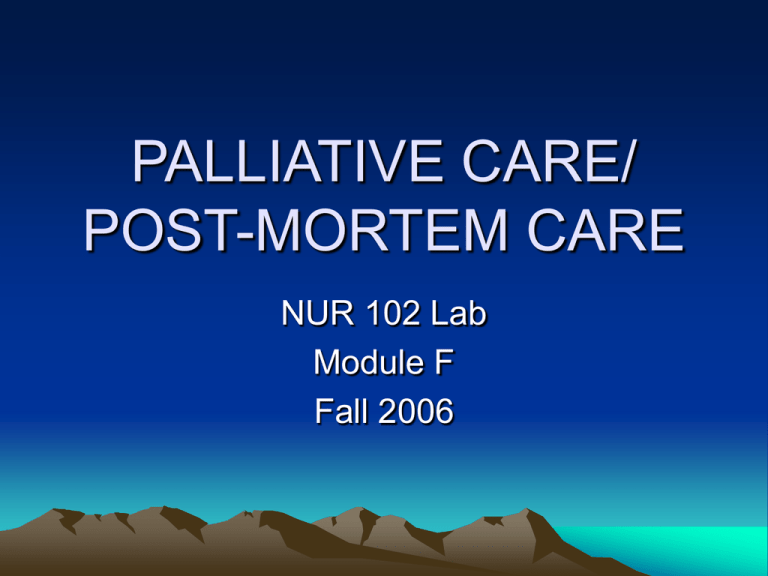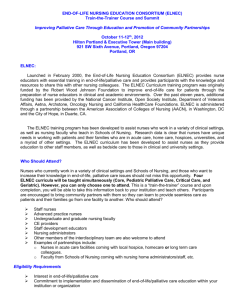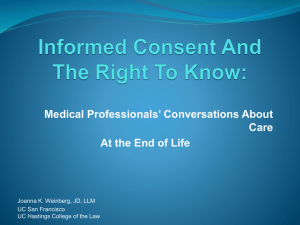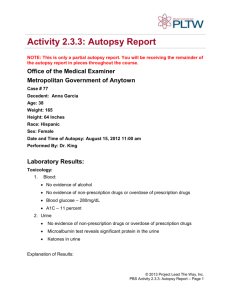Palliative-PostmortemCare
advertisement

PALLIATIVE CARE/ POST-MORTEM CARE NUR 102 Lab Module F Fall 2006 Essential Goals of Palliative Care • Prevention, relief, reduction, or soothing of symptoms • Allow clients to make informed choices • Achieve better relief of symptoms • Allow clients the opportunity to work on end of life issues • Allow client to experience a “good death” Hospice • Multidisciplinary, family centered program of care designed to assist the terminally ill through the phases of dying (pg. 167) • Physician, RN, LPN, aide, and chaplain are available to assist the client and family • Provide many services, such as respite care, medical equipment, medication • Services based on need, not ability to pay ELNEC • End-of-Life Nursing Education Consortium (ELNEC)-a national education initiative to improve end-of-life care in the United States. • Assist client and family through the grieving process • February 2000--funded by a major grant from The Robert Wood Johnson Foundation and has received additional funding from the National Cancer Institute, the Aetna Foundation, the Archstone Foundation, and the California Healthcare Foundation. Facts About ELNEC • Death often is seen as a failure of the health care system rather than a natural aspect of life. This belief affects all health professionals, including nurses. Despite their undisputed technical and interpersonal skills, professional nurses may not be completely comfortable with the specialized knowledge and skills needed to provide quality end-of-life care to patients. The ELNEC project gives nurses the knowledge and skills required to provide this specialized care and to positively impact the lives of patients and families facing the end of life. Continued… • ELNEC-Core content is divided into nine modules: Nursing Care at the End of Life; Pain Management; Symptom Management; Ethical/Legal Issues; Cultural Considerations in End-of-Life Care; Communication; Loss, Grief, Bereavement; Achieving Quality Care at the End of Life; and Preparation for and Care at the Time of Death. Achieving Quality Care at the End of Life; and Preparation and Care for the Time of Death. Continued… • Trainers represent each state and the District of Columbia. The states with the highest number of Trainers are California, Ohio, Pennsylvania and Texas with over 50 each. Thirteen other states have twenty or more ELNEC Trainers. • The American Journal of Nursing (AJN) published a bimonthly continuing education series on palliative nursing care in 2002 that featured the ELNEC project. The series used actual case studies to improve the way nurses care for dying patients, both physically and psychologically. The series can be viewed online at www.aacn.nche.edu/ELNEC/ajn.htm or www.ajnonline.com. Comfort • Management of symptoms of the disease and therapies • Symptom distress—the experience of discomfort or anguish related to the progression of a disease • Anxiety related to “fear of the unknown” • Worry or fear can increase ability to control pain Physical Changes of Death • Rigor mortis—stiffening of the body • Algor mortis—loss of skin elasticity • Livor mortis—purple discoloration of skin EBP Trends • Several research topics have been done to address palliative and end-of-life care • Barriers to a “good death” include differing expectations, lack of advanced directives or living wills, and clinicians ineffective communication skills • Pain control is a major concern • Clients do not want to be a “burden” and want to maintain sense of control Cultural Considerations Related to End-of-Life Issues • Chinese—the discussion of death is considered taboo and associated with bad luck and evil • Muslim—illness is a result of sin and death is part of life as destined by God • Orthodox Jews—do not leave the dying person alone; have “minyan” praying at the bedside Continued… • Hindu—may refuse food and pain medication because of belief in transmigration; head will face east with a lamp near the head; family will chant (mantra) and pray; they may spread incense and apply ash to the client’s forehead • Catholic—priest will anoint the client and give Holy Communion Theories of Grief and Mourning • Kubler-Ross’s Stages of Dying • Bowlby’s Phases of Mourning • Worden’s Task of Mourning Kubler-Ross • Elisabeth KublerRoss—behavioral theory • 5 Stages – – – – – Denial Anger Bargaining Depression Acceptance Quotes • “We run after values that, at death, become zero. At the end of your life, nobody asks you how many degrees you have, or how many mansions you built, or how many Rolls Royce's you could afford. That’s what dying patients teach you.” • “Guilt is perhaps the most painful companion of death.” Bowlby • Dr. John Bowlby— behavioral theory • 4 phases – Numbing – Yearning and searching – Disorganization and despair – Reorganization Worden • J. William Worden— behavioral theory • 4 tasks— – Accept reality of loss – Work through pain and grief – Adjust to the environment – Emotionally relocate the deceased Physical Signs and Symptoms of Impending Death • Hands, arms, feet, and legs become cool and pale • Increase in sleeping • Disorientation to time, place, or person • Incontinence • Lung congestion • Restlessness • Decreased nutritional intake – Refer to pg 179, table 7-2 Continued… • • • • Irregular pulse Decreased B/P Relaxation of jaw and facial muscles Cheyne-Stokes respiratory pattern Nursing Priorities • • • • • Adequate pain control Maintain independence Prevent isolation Spiritual comfort Support the family Care of the Body after Death • Post-mortem—after death • The Uniform Determination of Death Act (UDDA)—defines death as “irreversible cessation of circulatory and respiratory functions or irreversible cessation of all functions of the brain, including the brainstem” (pg. 180) • Post-mortem care must be done soon after death because of the changes the body undergoes Continued… • DNR—do not resuscitate • Omnibus Budget Reconciliation Act (OBRA) of 1986 • Autopsy—postmortem exam to determine the exact cause of death • Cultural considerations Organ Donation • Client must be on life-support to support vital organs • Family must understand that client is brain-dead • No age limit although parents must consent when client is under 18 years old • Indicate on drivers license request to be organ donor, although family makes the final decision Continued… • What can be donated? – Organs—heart, kidneys, pancreas, lungs, liver, intestines – Tissue—cornea, skin, heart valves, connective tissue – Bone marrow Organ donation does not affect the appearance of the body; an open casket is still possible Nursing Interventions • Provide private place for family discussion • Be sure that the decision is made by the appropriate person • Contact local donor registry • Inform family that body will be cared for • Be sure family understands that there is no cost for organ donation Autopsy • External Procedure – Body is brought to the morgue and photographed and x-rayed as indicated – Body is cleaned, weighed, and placed on autopsy table – The body is placed face up on the table, and a body block is placed under the patient's back. – A general description of the body is made and all identifying features are noted Continued… • Internal Examination – A large, deep, Y-shaped incision that is made from shoulder to shoulder meeting at the breast bone and extends all the way down to the pubic bone. – When a woman is being examined, the Yincision is curved around the bottom of the breasts before meeting at the breast bone. – The next step is to peel back the skin, muscle, and soft tissue Continued… Continued… – The chest flap is pulled up over the face, exposing the ribcage and neck muscles. – Two cuts are made on each side of the ribcage, and then the ribcage is pulled from the skeleton after dissecting the tissue behind it with a scalpel. – A series of cuts are made and organs are removed and weighed Continued… Continued… Continued… • Large organs are weighed on a grocer’s scale • Smaller organs are weighed on a triplebeam balance • Right lung: 300-400 gm • Left lung: 250-350 gm • Heart: 250-300 gm Continued… • • • • • Liver: 1100-1600 gm Adrenals: 4 gm or so each Thyroid: 10-50 gm Spleen: 60-300 gm Brain: 1150-1450 gm Continued… Autopsy Room Cultural Considerations • Refer to pg 181, Box 7-1 Post-Mortem Care • Always follow agency policy and procedure • Ensure that correct identification is on the body • Remove foley catheters, ET tubes, oxygen, and peripheral IV’s • Reinsert dentures if possible. If not, place them in cup to stay with body Continued… • Position body in natural position, avoid placing one hand over the other • Place small pillow under head and elevate the head of the bed 10-15 degrees • Close eyes, unless contraindicated by client’s religious preference • Shave men unless family requests otherwise Continued… • Wash body to remove blood, feces, and other drainage • Place pad under bottom • Remove any soiled dressings and replace with clean gauze. • Use only paper tape • Put on a clean gown and brush or comb hair Continued… • Gather all personal belongings into bag for family • For family viewing of the body, remove all unnecessary equipment, turn down lights, and provide seating for the family • Do not rush the family through this process • Transport body to morgue per agency policy References • US Department of Health and Human Services website at www.organdonor.gov. • http://health.howstuffworks.com/autopsy4. htm • http://www.deathonline.net/what_happens/ autopsy/autopsy_steps.cfm





